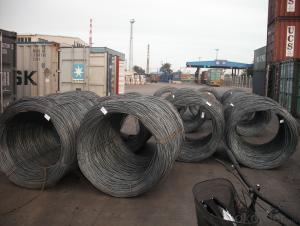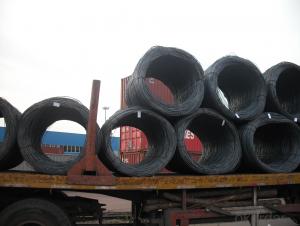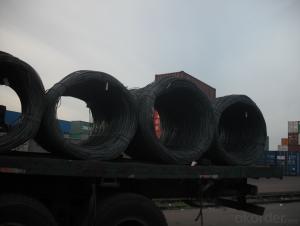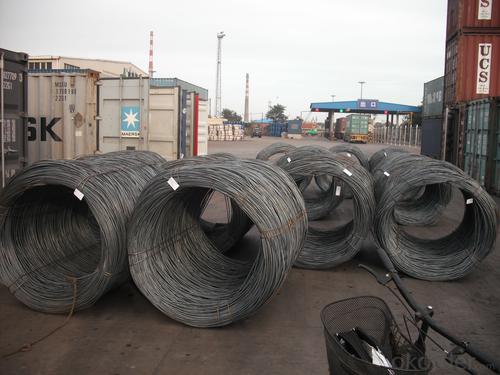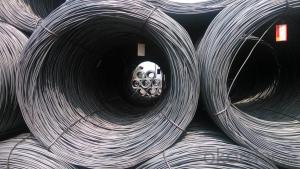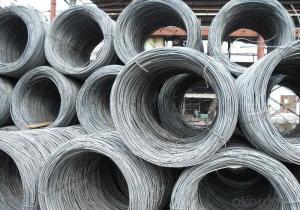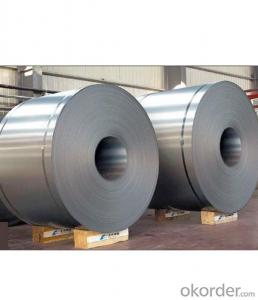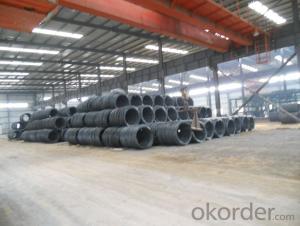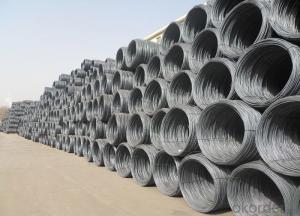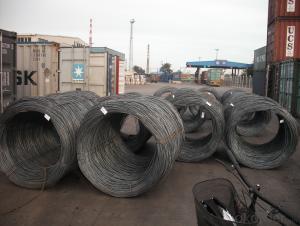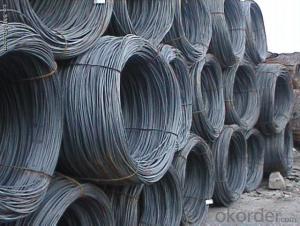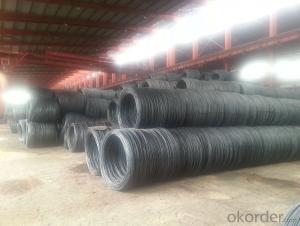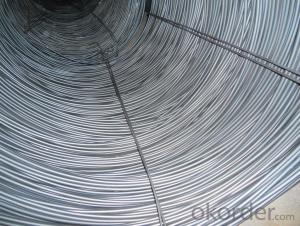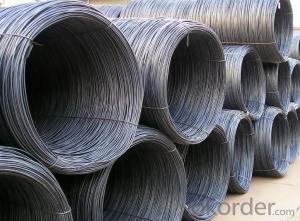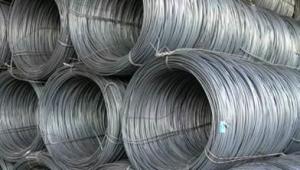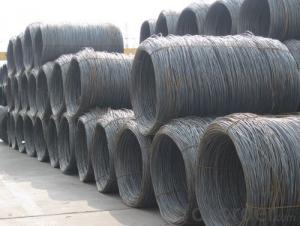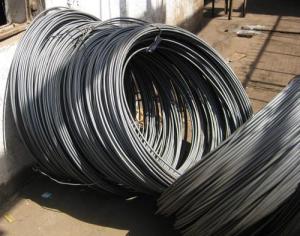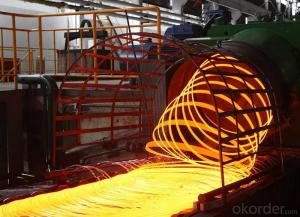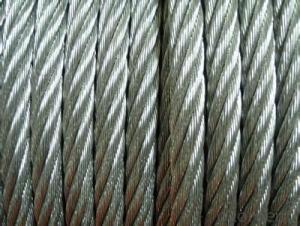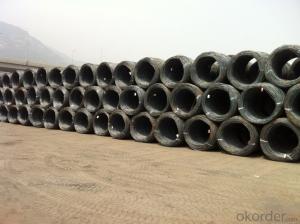Hot Rolled Carbon Steel Wire Rod Coil
- Loading Port:
- China Main Port
- Payment Terms:
- TT or LC
- Min Order Qty:
- -
- Supply Capability:
- -
OKorder Service Pledge
OKorder Financial Service
You Might Also Like
Product Description:
OKorder is offering Wire Rod at great prices with worldwide shipping. Our supplier is a world-class manufacturer of steel, with our products utilized the world over. OKorder annually supplies products to European, North American and Asian markets. We provide quotations within 24 hours of receiving an inquiry and guarantee competitive prices.
Product Applications:
After hot-rolled the products shaped into coil and delivery as finished product, including round, square, rectangular, hexagonal and so on. Since most of the products are round, it is generally called wire rod. Carbon steel wire rod is widely used in construction and manufacturing. Carbon steel wire rod is mainly used for reinforcement of reinforced concrete and welded structure or reprocessed (roberts , nail, etc.) materials, especially used to produce wire drawing, welding electrode, nails, spring, electronic, precise machinery parts and so on.
Product Advantages:
OKorder's Wire Rod are durable, strong, and resist corrosion.
Main Product Features:
· Premium quality
· Prompt delivery & seaworthy packing (30 days after receiving deposit)
· Corrosion resistance
· Can be recycled and reused
· Mill test certification
· Professional Service
· Competitive pricing
Product Specifications:
Steel Grade: Q195/235, SAE1006-1018B Standard: ASTM, GB
Diameter: 5.5mm, 6.5mm, 7mm,8mm,9mm,10mm,12mm,14mm
Type: in coil, coil weight around 2MT Alloy or Not: Alloy
Surface: round, no twisted, light and smooth Chemical Composition: (Please kindly find our chemistry of our material based on Q195、Q235A and Q235B as below for your information)
Trademark | Rank | Chemical composition (quality score) % | |||||
C | Si | Mn | S | P | |||
| ≤ |
| ≤ | ≤ | |||
Q195 |
| 0.06-0.12 | 0.30 | 0.25 | 0.050 | 0.045 | |
Q235 | A | 0.14-0.22 | 0.30 | 0.30-0.65 | 0.050 | 0.045 | |
Q235 | B | 0.12-0.20 | 0.30 | 0.30-0.70 | 0.045 | 0.045 | |
Trademark | Rank | Pulling Test | |||||
Bend PointΔs/Mpa | Tensile Strength | Elongation Ratioδ5% | |||||
Thickness (Diameter) /MM | Thickness (Diameter) /MM | ||||||
≤16 | 16-40 | ≤16 | 16-40 | ||||
≥ | ≥ | ||||||
Q195 |
| 195 | 185 | 315-390 | 33 | 32 | |
Q235 | A | 235 | 225 | 375-500 | 26 | 25 | |
Q235 | B | 235 | 225 | 375-500 | 26 | 25 | |
Payment:
-Invoicing on theoretical weight or actual weight as customer’s request.
-FOB, CFR or CIF.
-Regular terms of payment:
1, 30% payment in advance, the remaining balance (70% payment) against the copy of B/L.
2, 30% payment in advance, the remaining balance (70% L/C) against the copy of B/L.
3, Negotiable.
FAQ:
Q1: Why buy Materials & Equipment from OKorder.com?
A1: All products offered byOKorder.com are carefully selected from China's most reliable manufacturing enterprises. Through its ISO certifications, OKorder.com adheres to the highest standards and a commitment to supply chain safety and customer satisfaction.
Q2: How do we guarantee the quality of our products?
A2: We have established an advanced quality management system which conducts strict quality tests at every step, from raw materials to the final product. At the same time, we provide extensive follow-up service assurances as required.
Q3: Can stainless steel rust?
A3: Stainless does not "rust" as you think of regular steel rusting with a red oxide on the surface that flakes off. If you see red rust it is probably due to some iron particles that have contaminated the surface of the stainless steel and it is these iron particles that are rusting. Look at the source of the rusting and see if you can remove it from the surface.
Images:
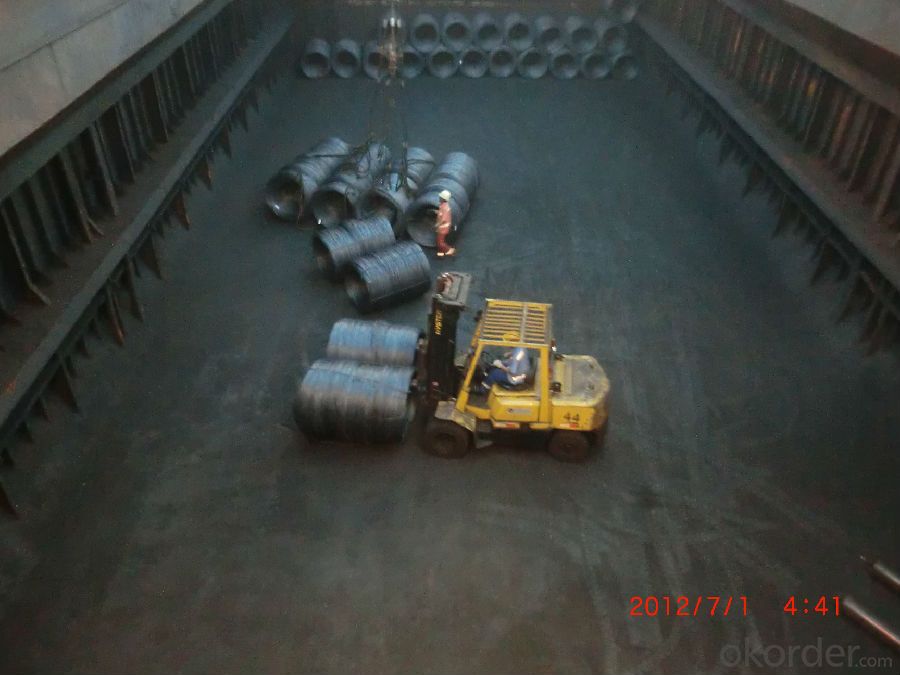
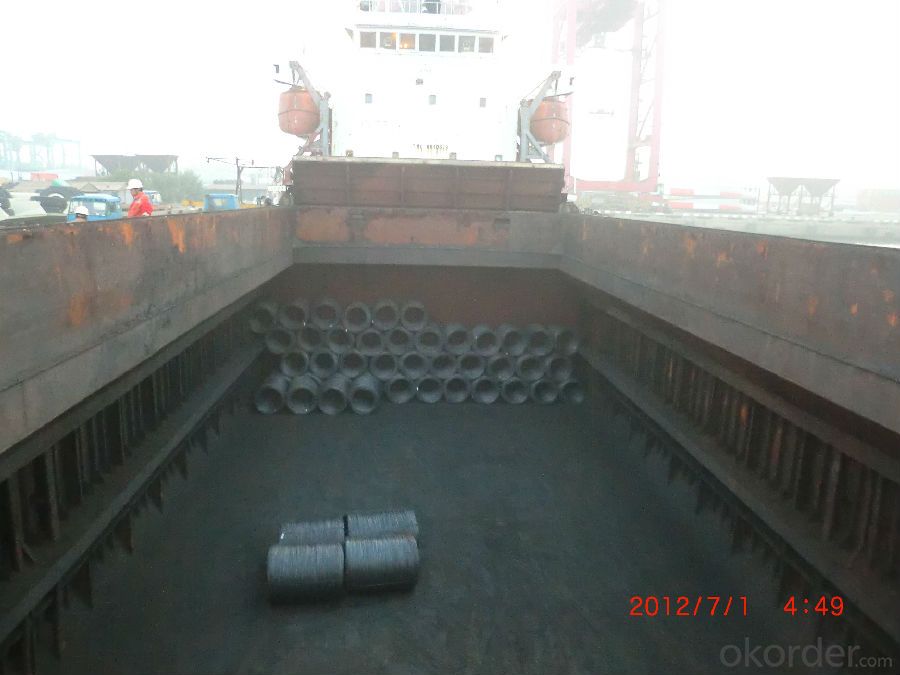
- Q: What are the main factors affecting the thermal conductivity of steel wire rod?
- The main factors affecting the thermal conductivity of steel wire rod are the composition of the steel, the microstructure of the wire rod, its temperature, and any impurities or defects present in the material.
- Q: How is steel wire rod used in the manufacturing of wire for geotechnical applications?
- Steel wire rod is widely used in the manufacturing of wire for geotechnical applications due to its exceptional strength, durability, and versatility. Geotechnical applications primarily involve soil stabilization, erosion control, and reinforcing structures in civil engineering projects. Firstly, steel wire rod is used to manufacture geogrids, which are high-strength woven or welded wire mesh structures. Geogrids are employed to reinforce soil and provide stabilization in various applications such as retaining walls, embankments, and slopes. The steel wire rod is formed into a mesh pattern and then coated with a protective material to enhance its resistance to corrosion and environmental factors. Additionally, steel wire rod is utilized in the production of steel strand cables, which are essential in geotechnical engineering for post-tensioning applications. These cables are used to reinforce concrete structures such as bridges, buildings, and foundations. The steel wire rod is twisted into strands and then bundled together to form a high-tensile strength cable. This cable is embedded in concrete and post-tensioned to provide additional support and prevent structural failure. Moreover, steel wire rod is employed in the manufacturing of gabions, which are wire mesh containers filled with stones or other materials. Gabions are widely used for erosion control, slope stabilization, and retaining walls. The steel wire rod is woven or welded to form a mesh cage-like structure, which is then filled with stones. The gabions provide a flexible and permeable structure that can absorb impact, prevent soil erosion, and stabilize slopes. In summary, steel wire rod plays a crucial role in the manufacturing of wire for geotechnical applications. Its strength, durability, and adaptability make it an ideal material for reinforcing soil, stabilizing slopes, and reinforcing structures. Whether in the form of geogrids, steel strand cables, or gabions, steel wire rod contributes significantly to the safety, stability, and longevity of various geotechnical engineering projects.
- Q: What are the different types of steel wire rod coatings?
- There are various types of steel wire rod coatings, including galvanized, zinc-aluminum alloy, copper-coated, and epoxy coatings.
- Q: How is the dimensional accuracy of steel wire rod ensured?
- The dimensional accuracy of steel wire rod is ensured through a series of manufacturing and quality control processes. Firstly, the steel wire rod is produced using a continuous casting or hot rolling method, where the dimensions are closely monitored and controlled. This initial process ensures that the diameter and shape of the wire rod are within the desired tolerances. Once the wire rod is formed, it undergoes various mechanical treatments such as drawing, annealing, and cooling. These processes further refine the dimensions and improve the mechanical properties of the wire rod. Drawing involves pulling the wire rod through a series of dies with progressively smaller diameters, which helps in achieving the desired diameter with high precision. During the manufacturing process, regular inspections and measurements are carried out to ensure the dimensional accuracy of the wire rod. This includes using advanced measurement techniques such as laser-based measuring systems or optical scanners to check the diameter, roundness, and surface quality of the wire rod. Additionally, quality control procedures are implemented to ensure that the wire rod meets the required dimensional standards. This involves taking samples at regular intervals and measuring their dimensions to verify compliance with the specified tolerances. Any deviations from the desired dimensions are identified and appropriate corrective actions are taken to maintain the dimensional accuracy. Overall, the dimensional accuracy of steel wire rod is ensured through a combination of precise manufacturing techniques, mechanical treatments, regular inspections, and quality control procedures. These measures guarantee that the wire rod meets the dimensional requirements for its intended applications.
- Q: What are the advantages of using steel wire rod over other materials?
- Steel wire rod offers numerous advantages compared to other materials. Firstly, its exceptional strength and durability make it ideal for applications requiring reliability. It can withstand heavy loads and stresses, making it suitable for industries such as construction, automotive, and manufacturing. Secondly, steel wire rod is highly versatile as it can be easily fabricated into various shapes and sizes to meet specific project requirements. This flexibility allows for a wide range of applications, including wire ropes, springs, cables, fencing, and reinforcement in concrete structures. Moreover, steel wire rod exhibits excellent corrosion resistance properties, ensuring a longer lifespan and reduced maintenance costs. This makes it suitable for outdoor and marine applications, where exposure to moisture and harsh weather conditions is common. Additionally, steel wire rod is cost-effective due to its abundance and widespread availability. Its durability and resistance to wear and tear also contribute to lower replacement and maintenance costs in the long run. Lastly, steel wire rod promotes environmental sustainability as steel is one of the most recycled materials globally. Using steel wire rod helps conserve natural resources and reduce carbon emissions by reducing the need for new production. In summary, the advantages of steel wire rod include its exceptional strength, versatility, corrosion resistance, cost-effectiveness, and environmental sustainability. These qualities make it a preferred choice for a wide range of applications across different industries.
- Q: What are the different surface coating materials used for steel wire rod?
- There are several different surface coating materials that can be used for steel wire rod to enhance its properties and protect it from corrosion. Some of the commonly used surface coating materials for steel wire rod include: 1. Zinc: Zinc coating is one of the most widely used surface coatings for steel wire rod. It provides excellent corrosion resistance and acts as a sacrificial layer, protecting the underlying steel from rust and oxidation. Zinc-coated steel wire rods are commonly known as galvanized wire rods. 2. Epoxy: Epoxy coatings are often used for steel wire rods that require resistance to chemicals, moisture, and abrasion. Epoxy coatings provide a durable, smooth, and protective layer that helps to prevent corrosion and improve the overall performance of the wire rod. 3. Phosphating: Phosphating is a surface treatment process that involves the conversion of the metal surface into a layer of phosphate crystals. Phosphating enhances the adhesion of subsequent coatings or paints, providing better corrosion resistance and improving the overall appearance of the steel wire rod. 4. Polymer Coatings: Polymer coatings are commonly used for steel wire rods that require specific properties such as electrical insulation, UV resistance, or high temperature resistance. These coatings are typically made from polymers such as PVC (polyvinyl chloride) or PE (polyethylene) and are applied using various techniques such as extrusion or dip coating. 5. Organic Coatings: Organic coatings, such as paints or lacquers, can also be used as surface coatings for steel wire rods. These coatings provide aesthetic appeal, as well as protection against corrosion and environmental factors. Organic coatings can be applied in various colors and finishes to meet specific requirements. It is important to note that the choice of surface coating material for steel wire rod depends on the intended application, environmental conditions, and desired properties. Manufacturers typically select the most suitable coating material based on the specific requirements of the wire rod and the end-use of the product.
- Q: What are the common production processes for osmium-coated steel wire rod?
- The common production processes for osmium-coated steel wire rod include wire drawing, cleaning and degreasing, osmium coating through methods like electroplating or physical vapor deposition, and final heat treatment for improved hardness and durability.
- Q: How is steel wire rod used in the production of tire reinforcement materials for vehicles?
- Steel wire rod is commonly used in the production of tire reinforcement materials for vehicles due to its high tensile strength and durability. The wire rod is typically formed into individual wires, which are then woven or wrapped into a mesh-like structure known as tire cord. This tire cord is embedded into the rubber compound during the tire manufacturing process, providing the necessary strength and stability to the tire. The steel wire rod ensures that the tire can withstand the forces and stresses encountered during vehicle operation, improving overall tire performance and longevity.
- Q: What are the main factors affecting the quality of steel wire rod?
- There are several main factors that affect the quality of steel wire rod. Firstly, the chemical composition of the steel plays a crucial role. The presence of impurities, such as sulfur and phosphorus, can significantly impact the strength, ductility, and overall quality of the wire rod. Therefore, strict control over the chemical composition is essential to ensure high-quality steel wire rod. Secondly, the manufacturing process and the quality of raw materials used are important factors. The steelmaking process, including melting, refining, and casting, must be carefully controlled to avoid any contamination or defects that could weaken the wire rod. The quality of the raw materials, such as iron ore and scrap metal, also affects the final product. Using high-quality raw materials can result in enhanced mechanical properties and overall quality of the wire rod. Thirdly, the heat treatment process is crucial in determining the quality of steel wire rod. Proper heat treatment, which involves controlled heating and cooling processes, can significantly improve the mechanical properties of the wire rod, such as tensile strength and hardness. It also helps in reducing internal stresses and improving the microstructure of the steel, thereby enhancing its overall quality. Another important factor is the surface quality of the wire rod. Any surface defects, such as cracks, scale, or unevenness, can adversely affect the wire rod's performance in various applications. Therefore, proper surface preparation and inspection are necessary to ensure a smooth and defect-free surface. Furthermore, the mechanical and physical properties of the steel wire rod, such as tensile strength, ductility, and toughness, greatly impact its quality. These properties are influenced by various factors, including the steel's microstructure, grain size, and the presence of any residual stresses. It is important to control and optimize these factors during the manufacturing process to achieve the desired mechanical and physical properties. Lastly, adherence to stringent quality control measures throughout the entire production process is crucial in ensuring the quality of steel wire rod. Regular testing and inspection of the raw materials, intermediate products, and final wire rod are essential to detect any deviations or defects and take corrective actions promptly. In conclusion, the main factors affecting the quality of steel wire rod include the chemical composition, manufacturing process, heat treatment, surface quality, mechanical and physical properties, and adherence to quality control measures. By carefully controlling and optimizing these factors, manufacturers can produce high-quality steel wire rod that meets the desired specifications and performance requirements.
- Q: Can steel wire rod be used in the production of wire ropes?
- Yes, steel wire rod can be used in the production of wire ropes. Wire ropes are typically made by twisting multiple strands of steel wires together to form a strong and flexible rope. Steel wire rod is often used as the raw material for manufacturing these wires, as it possesses the necessary strength and durability required for wire rope production.
Send your message to us
Hot Rolled Carbon Steel Wire Rod Coil
- Loading Port:
- China Main Port
- Payment Terms:
- TT or LC
- Min Order Qty:
- -
- Supply Capability:
- -
OKorder Service Pledge
OKorder Financial Service
Similar products
Hot products
Hot Searches
Related keywords
